This post may contain affiliate links at no additional cost to you. As an Amazon Associate I earn from qualifying purchases. Click to view our full disclosure.
What's inside
If you’ve ever signed up to a gym and been given a complimentary program, you’ve no doubt seen the lat pulldown.
This exercise has been a staple of back workouts for decades, as it’s a fun, safe, and effective back builder.
But, if you clicked on this article, you’re obviously looking for a change!
Maybe you don’t have access to a lat pulldown machine at the moment, or maybe you just want something different.
We’ve got you covered!
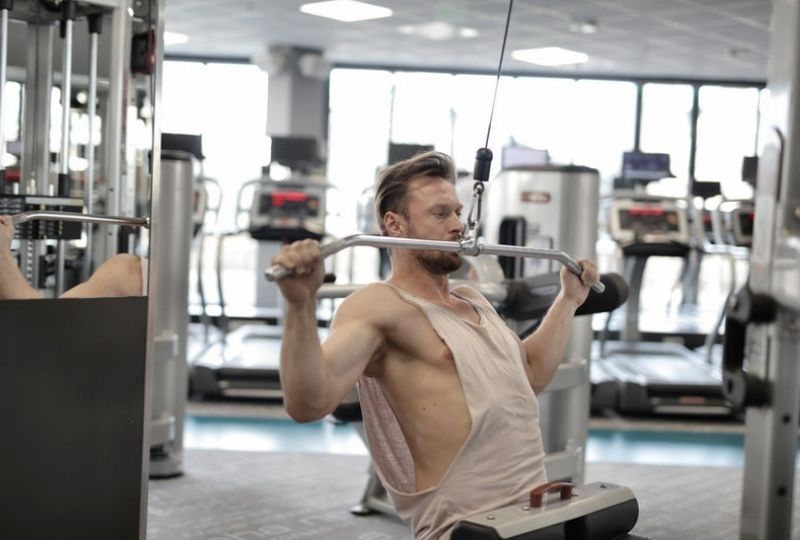
This article provides a number of the best alternatives to lat pulldowns, neatly broken down by the equipment they require.
There are options here for every fitness level and equipment option, and we’ve thrown in some example workouts for you to try as well.
Table of Contents:
- Muscles Used in the Lat Pulldown
- 14 Best Lat Pulldown Substitutes to Target the Same Muscle Group
- Lat Pulldown alternatives at home
- Pullups
- Suspended row
- Lat Pulldown alternatives with dumbbells
- Dumbbell pullover
- Supported dumbbell row
- Lat Pulldown alternatives with barbell
- Yates row
- Single arm landmine row
- Barbell rollout
- Lat Pulldown alternatives with bands
- Kneeling straight arm pulldown
- Assisted pull-up
- Lat Pulldown alternatives with machines
- Lat pullover machine
- Assisted pull-up machine
- Lat Pulldown alternatives with cables
- Straight arm pulldown
- Kneeling underhand lat pulldown
- Kneeling wide grip lat pulldown
- Lat Pulldown alternatives at home
- Lat Pulldown Alternative Workout
- FAQs
- Closing Comments
Muscles Used in the Lat Pulldown
Related: How To Get A Thicker Neck
The following superficial muscles are the prime movers in the lat pulldown exercise:
- Latissimus dorsi (large muscles running down either side of the back)
- Trapezius (diamond-shaped mid-back muscle, extending from neck to shoulders to spine)
- Posterior deltoid (rear shoulders)
- Biceps brachii (upper arm elbow flexors)
For a more complete breakdown of the musculature of the back and biceps, check out our complete guide to back and bicep training.
What are the benefits of the lat pulldown?
Perhaps the biggest benefit of the lat pulldown is that it provides a vertical pull exercise that can be scaled to any ability level.
Another advantage of the lat pulldown machine is that it’s quite a safe machine to use.
Lat pulldown machines are also widely available in gyms, and many facilities have more than one machine.
In addition, the lat pulldown can be modified with many different types of handles, either to change the focus of the movement or for comfort.
What are the drawbacks of the lat pulldown?
Although it’s a great exercise, the lat pulldown does have some disadvantages compared to other back exercises.
Firstly, securing the lower body into the seat and leg rest means that you miss out on recruiting the core and lower body throughout the movement.
While this might be good in the short term to focus on those lats, it limits your progress to more advanced exercises.
You might get really strong in lat pulldowns and think you’ll be able to jump right into pull-ups, for example.
However, having that lower body supported will have limited your core strength and ability to extinguish energy leaks in a free-hanging position.
That being said, whatever your reasons for not doing lat pulldowns, we’re here to provide you with the best lat pulldown alternative exercises possible to increase your size and strength.
14 Best Lat Pulldown Substitutes to Target the Same Muscle Group
Related: 10 Best Vertical Pull Exercises
The following lat pulldown alternatives are broken down by the different equipment requirements.
Whether you have access to machines, free weights, or just your own body weight, there are exercise options here for you.
Each of these exercises will perform one of the two main functions of the lat pulldown: to mimic a vertical pull compound movement or to isolate and target the lat muscles.
Lat Pulldown Alternatives at Home

1. Pull-Ups
The first exercise on this list has to be the pull-up. While it’s a difficult exercise to get into, it’s 100% worth the effort.
Pull-ups can do everything the lat pulldown can and more – without needing a machine.
While grips and styles of pull-ups can be changed depending on your preferences, they all do one thing exceptionally well: engage the lats.
Fitness Equipment Required:
- Pull-up bar or substitute
- Olympic rings (variation)
- Chalk / gloves / straps (optional)
How-To Perform Exercise:
- Hold the bar with your chosen grip style.
- Bend the knees if necessary to enter a dead hang.
- Retract and depress the shoulder blades and engage the core.
- Pull the elbows down and back, lifting the chin up over the bar.
- Hold at the top, and slowly lower to the starting position.
Pro Tips:
- Always perform pull-ups from full extension to full range over the bar.
- Use the assisted pull-up variations below to build up to a full pull-up.
- Add a weight belt or hold a dumbbell between the feet for weighted pull-ups if you’re an advanced lifter.
2. Suspended Row
Another great bodyweight option for home is the suspended row, or suspension trainer inverted row.
This exercise is the bodyweight equivalent of a lat pulldown in the sense that it can be scaled and modified for any fitness level.
What makes it potentially better than a lat pulldown is that these adjustments can be done mid-set, which isn’t possible on the lat pulldown machine.
If you want to tweak this exercise to focus on the lats as much as possible, research has found the pronated or overhand grip to produce the greatest level of lat activation.
Fitness Equipment Required:
- Suspension straps
- One or two towels (variation)
How-To Perform Exercise:
- Holding the suspension handles firmly, lean back with locked out arms, taking up the slack.
- Walk the feet out until your body forms a straight line at the desired angle for your ability.
- Squeezing the glutes and hamstrings to lift the hips, draw the elbows down and back.
- Lift the chest high as you pull the shoulder blades together.
- Hold at the top briefly, and slowly lower back to the starting position.
Pro Tips:
- As mentioned, you can adjust the difficulty mid-set – simply move the feet forward or back to adjust on the fly.
- If you don’t have a suspension trainer, a couple of towels and a post or doorway will do the trick as well.
Lat Pulldown Alternatives With Dumbbells
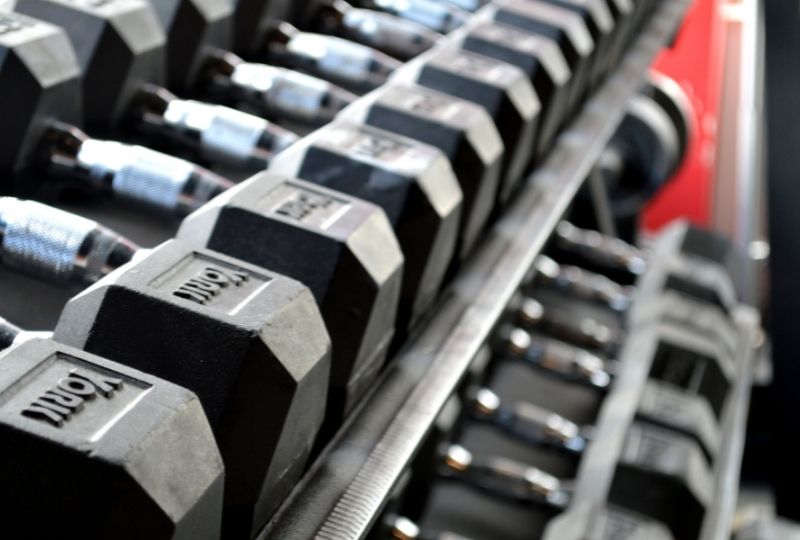
3. Dumbbell Pullover
After the bodyweight movements above, the next step is to bring in some free weights for some open-chain lat action.
Although there are several variations of this type of movement on this list, the dumbbell pullover has the unique factor of putting tension through the lats in their most stretched position.
This creates a need for the lats to contract against letting the shoulders overextend.
The dumbbell pullover is an exercise you can use to really engage the lats without needing to use a lot of weight.
Fitness Equipment Required:
- Dumbbell
- Bench
- Bosu ball (variation)
How-To Perform Exercise:
- Lay across a weight bench with the feet flat on the floor.
- Holding a barbell at the chest, hold one end of the dumbbell with the palms facing up to lift the weight above the chest.
- Keeping the elbows locked, slowly extend the shoulders overhead, stretching the weight toward the ground.
- Keep the ab muscles engaged as you feel a good stretch at the bottom, then contract back up to the starting position.
Pro Tips:
- Perform this exercise across the bench to allow an even greater stretch by dropping the hips.
- While the chest and triceps will be working here, focus on the connection to the lats throughout the movement.
- Don’t let the elbows bend; this is not a tricep extension.
4. Supported Dumbbell Row
The chest-supported row is a great dumbbell mass builder for the back and biceps.
Prone bench pulls, as they’re also known, are a pulling exercise used by athletes in everything from canoeing and cross-country skiing to swimming and combat sports.
The benefits of using dumbbells here are twofold.
First, to allow a greater range of motion (the bar is stopped by the bench). Second, to allow each arm to work independently.
Fitness Equipment Required:
- Incline bench
- Dumbbells
- Bosu ball (variation)
How-To Perform Exercise:
- Set up the bench at a roughly 45-degree angle and have the dumbbells on either side for easy access.
- Lay with your chest on the bench, legs straight and feet planted.
- Pick up the dumbbells and engage the entire posterior chain, keeping the neck neutral.
- Drive the balls of the feet into the ground and squeeze the glutes as you pull the elbows up and back.
- Row the weights to either side of the torso and hold briefly, squeezing the shoulder blades back and down.
- Slowly control the weights to the starting position.
Pro Tips:
- You can adjust the incline angle of the bench to target different muscles; lower angles will require more activity from the lats.
- Pull the dumbbells up and back through an arcing motion while really focusing on letting the lats do the work.
- Avoid arching the back on this exercise; don’t allow the chest to lift off the bench.
Lat Pulldown Alternatives With Barbell

5. Yates Row
Essentially a bent-over row, the Yates row earns a place on this list as an effective barbell exercise for the back and arms.
Compared to other compound row variations, I personally find the Yates row to provide a great connection when squeezing the lats to pull the elbows up and back.
It’s also important to include an exercise like this as it is a whole-body movement, requiring a lot of core strength and coordination to support the upper limb motion.
Fitness Equipment Required:
- Barbell
- Weight plates
- Chalk / gloves / straps (optional)
How-To Perform Exercise:
- Stand in front of the bar with the feet shoulder-width and a supinated grip slightly wider than shoulder-width.
- Lift the bar to standing and tip forward at the hips until the bar is just above the knees.
- Keep the back straight as you pull the bar into your belly button.
- Squeeze the lats and arms at the top and keep them active as you slowly return to the starting position.
Pro Tips:
- Keep the same angle in the hips; don’t cheat (or hurt) yourself by swinging the weight up.
- If you haven’t tried it, it’s worth trying a move like this with lifting straps. This can really help you focus on the major muscles without grip strength limiting you.
6. Single-Arm Landmine Row
If you do have access to a barbell, whether at your home gym or a commercial facility, this is another awesome inclusion to this list.
While the T-bar row is a staple for upper-mid back development, its single-arm counterpart is a great lat builder.
The added benefit of this move is that it’s super functional, building in a lot of anti-rotational strength through the torso as you stabilize for the rowing action.
Fitness Equipment Required:
- Barbell
- Weight plates
- Landmine attachment (optional)
How-To Perform Exercise:
- Stand next to the bar behind the plates at the top, with the feet shoulder-width.
- Hinge forward from the hips, setting up in the same way as you would for a deadlift or bent-over row.
- Grab the bar with the hand closest, and lift it up to knee height while maintaining a straight back.
- From a hanging position, keep the elbow in as you pull the elbow past the midline of the torso.
- Slowly and without twisting, lower the arm straight.
Pro Tips:
- Start with a light weight to get a feel for the unusual balance of this exercise.
- If you don’t have a landmine attachment, simply anchor the bottom end of the bar in the hole of a weight plate placed flat on the floor.
7. Barbell Rollout
You might see this exercise and immediately think, “Isn’t that for your abs?”
While the rollout definitely is a core strengthening exercise, people often miss the fact that it requires a super-hard contraction of the lats as well.
While the abs work to maintain trunk flexion, it’s actually the lats that do the hard work, extending the shoulders to avoid face planting.
Try this move with a new focus on the lats and we guarantee you’ll be converted.
Fitness Equipment Required:
- Barbell
- Weight Plates
- Ab roller (variation)
How-To Perform Exercise:
- Kneel in front of the bar with the knees and hands shoulder-width apart.
- Keep a straight line from the knees to the shoulders and squeeze the butt as you roll the bar forward.
- At the bottom of the movement, squeeze the lats hard and focus on pushing the bar down into the ground as you drag it back to the starting position.
Pro Tips:
- Of course, the rollout is usually seen as an ab exercise, so expect them to be working hard here, too.
- If you have an ab wheel at home, try this for your lats as well.
Lat Pulldown Alternatives With Bands
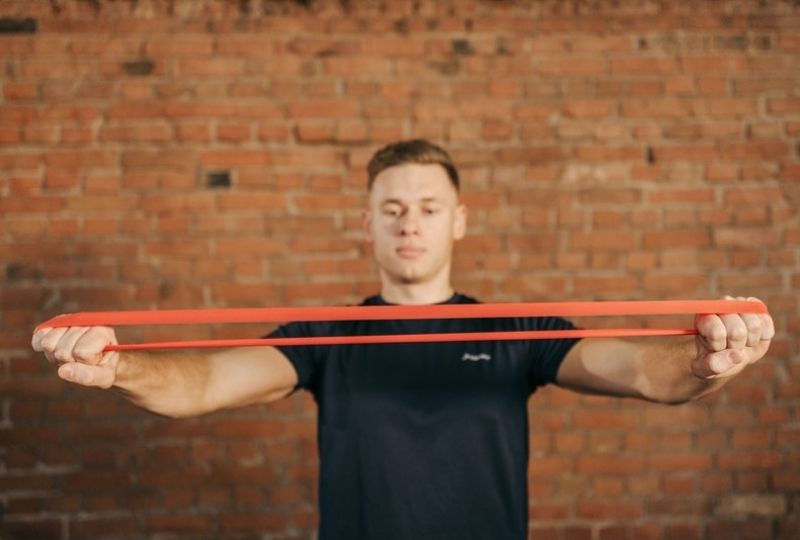
8. Kneeling Straight Arm Pulldown
After a few heavy barbell lifts, let’s get back to some exercises that will stimulate growth in the lats with less recovery time.
The first of these resistance band moves is the kneeling straight arm pulldown.
This exercise has a couple of advantages over its cable counterpart, earning it a place on this list.
First, the individual handles of a band mean that you can get more range of motion on either side of your body.
Also, the band creates more resistance the further you pull, giving the lats a huge squeeze in the shortened position.
Fitness Equipment Required:
- Resistance band
How-To Perform Exercise:
- Anchor the band to a high attachment point.
- Kneel on a comfortable surface.
- Start with straight arms, leaning forward at the hips with a straight back.
- Pull the hands down and back, keeping the elbows locked.
- Squeeze the lats and try to extend the shoulders as far as possible.
- Control the hands back to a stretch position.
Pro Tips:
- Don’t let the band fling your arms back, control the movement.
- Don’t cheat into shoulder extension by bending your back forward, just stay within your ability level.
9. Assisted Pull-Up
Another great use for the resistance band in this context is to assist you with achieving pull-ups.
Since the lat pulldown is used as a crutch by many people who struggle with pull-ups, this exercise is perfect as a lat pulldown alternative!
Resistance bands have been found to be a useful alternative to cable machines for strength training, so make the most of them.
Fitness Equipment Required:
- Resistance band
- Bar or similar place to tie band
How-To Perform Exercise:
- Anchor the band to the bar.
- Pull the band down, carefully placing one foot inside the loop.
- Place the hands in the desired width and grip either side of the anchor point.
- Straighten the leg inside the band until the feet are side by side.
- Engage the shoulder blades and pull the chin over the bar.
- Slowly lower yourself to full lockout at the bottom.
Pro Tips:
- Don’t let the band bounce you into the next rep, you control the movement.
- Use progressively lighter bands until you can try full bodyweight pull-ups.
Lat Pulldown Alternatives With Machines
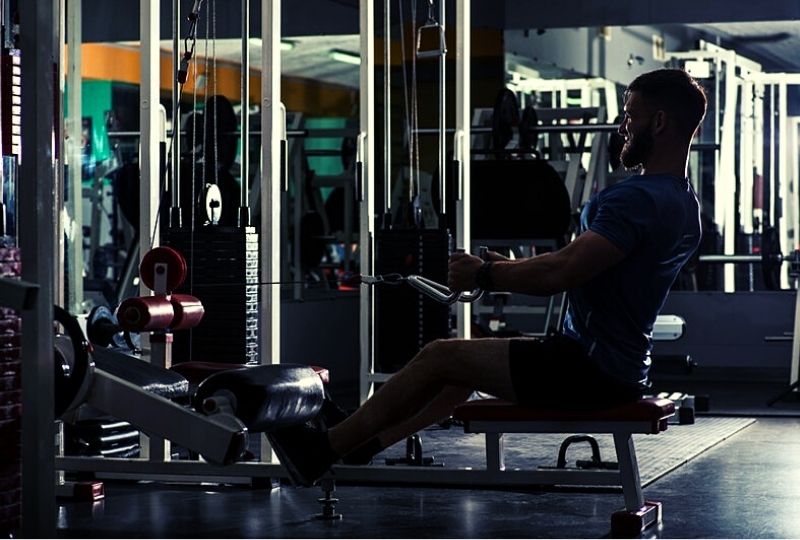
10. Lat Pullover Machine
If you have access to this machine, it’s a must-try as a lat pulldown alternative.
The lat pullover machine has the weight driven from the elbows as opposed to the hands.
This takes the triceps out of the equation and often results in people really being able to feel the lats perform the shoulder extension.
The machine also allows good customization depending on your shoulder mobility.
Fitness Equipment Required:
- Lat pullover machine
How-To Perform Exercise:
- Set the weight, seat, and pads to the appropriate level.
- Breathe in as you extend the shoulders overhead.
- Breathe out and drive the elbows down, through, and back.
- Slowly resist the movement as the weight pulls your arms back to the top.
Pro Tips:
- Focus on the downward portion of the movement to engage the lats effectively.
- Take advantage of the assisted stretch this machine provides.
11. Assisted Pull-Up Machine
Another machine option for a lat pulldown alternative is the assisted pull-up machine.
Common in many gyms, this machine uses the weight to counterbalance your own.
This means you can make pull-ups as easy as you like, helping you get comfortable with the movement.
Fitness Equipment Required:
- Assisted pull-up machine
- Standing assisted pull-up machine (variation)
How-To Perform Exercise:
- Set the weight to counterbalance your body weight.
- Place your knees (or feet) on the pad, holding on as you take up the slack.
- As in the kneeling pulldown, squeeze the glutes and keep the body straight.
- Slowly lower yourself until the arms are straight, then drive the chest up as you pull to the top.
Pro Tips:
- Don’t pull up too quickly as this builds momentum for the counterweight.
- Keep the body straight and avoid sitting the hips back to cheat the pad up.
Lat Pulldown Alternatives With Cables
Related: The Best Upper Lower Split Workout
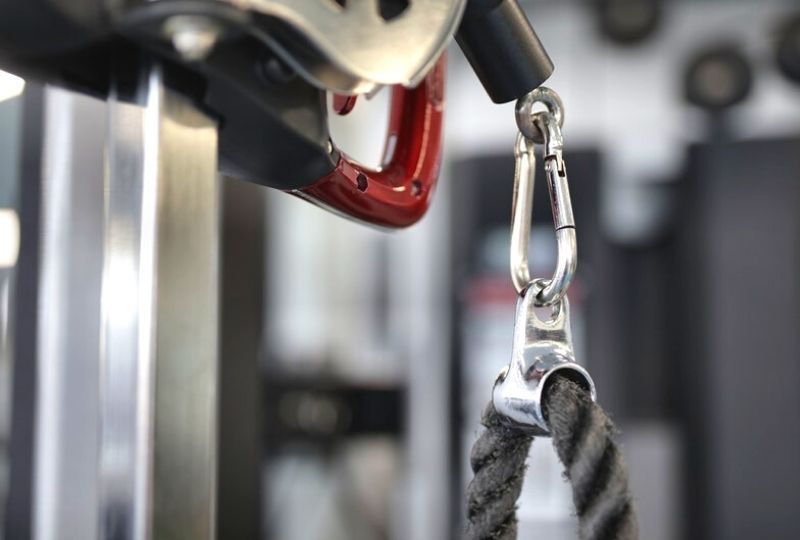
12. Straight Arm Pulldown
Moving on to the cable machines, the straight arm pulldown is a common lat-focused exercise in many programs.
As a classic shoulder extension movement, this move isolates the lats well, providing a steady resistance throughout the range of motion.
This exercise is particularly good for building lat strength in a shortened position, which can provide a boost to your deadlift strength.
Fitness Equipment Required:
- Cable machine
- Straight bar handle
- Resistance band (variation)
How-To Perform Exercise:
- Stand in front of the cable machine with the handle set high.
- Lean forward slightly at the hips to create a slight stretch in the lats.
- Flare the lats and pull the bar in an arc down toward your thighs.
- Pull the handle back and into your body, squeezing the lats hard.
- Slowly control back to the starting position, keeping tension on the muscle.
Pro Tips:
- Like the dumbbell pullover, keep the elbows locked to avoid making this a tricep exercise.
- Experiment with different handles, such as the rope handle, to see what helps you connect with the muscle the most.
Related: Ultimate Cable Chest Workout: 16 Cable Chest Exercises For Mass
13. Kneeling Underhand Lat Pulldown
Research has found the kneeling pulldown to be superior to the seated version in more closely mimicking the muscle activation of the pull-up.
The underhand variation allows a good range of motion for the lats and provides a good pump for the biceps as well.
Fitness Equipment Required:
- Cable machine
- Resistance band (variation)
How-To Perform Exercise:
- Set the cable handle to a high setting that you can reach from a kneeling position.
- Kneel in front of the handle, reaching up to hold the bar.
- Squeeze your butt, push the hips forward slightly, and lift the chest.
- Keeping the eyes up, pull the bar toward the lower chest.
- Hold the bar at the sternum, contracting the entire posterior chain.
- Slowly control the weight back to the starting position.
Pro Tips:
- This exercise has a limit when the weight you’re able to lift becomes too much to keep yourself on the ground.
- You can anchor yourself by hooking the feet under a heavy barbell.
14. Kneeling Wide Grip Lat Pulldown
This exercise is simply a variation of the previous lat pulldown alternative.
Again, the kneeling pulldown is more versatile and more functional than a traditional seated lat pulldown machine.
Fitness Equipment Required:
- Cable machine
- Wide handle
- Resistance band (variation)
How-To Perform Exercise:
- Set up in the same way as above.
- This time, grip the bar in a wide, pronated position.
- Flare the lats out as you pull the elbows out and down.
- Squeeze at the bottom and slowly return up.
Pro Tips:
- Modify this exercise by trying different cable heights and distances from the anchor point.
Lat Pulldown Alternative Workout
Related: Gorilla Mode Pre Workout Review
The following workout examples are short but effective options for your back or pull day using the above lat pulldown alternatives.
There are home and full gym options for both beginner and more advanced lifters.
Of course, please warm up and stretch appropriately before and after performing any of these workouts to get the most out of them while minimizing injury risk.
Beginner
| Beginner Home | Beginner Gym |
| Suspended row 3xMAX | Assisted pull-up machine 3×12 |
| Kneeling straight arm pulldown (band) 3×12 | Supported dumbbell row 3×12 |
| Kneeling underhand pulldown (band) 3×12 | Cable straight arm pulldown 3×12 |
Advanced
| Advanced Home | Advanced Gym |
| Pull-ups 3xMAX | Yates row 3×10 |
| Dumbbell pullover 3×10 | Pull-ups 3xMAX |
| Supported dumbbell row 3×10 | Pullover machine 3×12 |
Frequently asked questions
How can I mimic the lat pulldown at home?
Aside from buying a multi-purpose home gym or rack with pulley attachments, there are other ways to make your own lat pulldown apparatus at home.
All you need is a resistance band (and somewhere overhead to anchor it to) and a relatively thick length of dowel.
These items cost as little as a few dollars each, making them a budget-friendly but effective option.
To recreate the lat pulldown with this equipment, simply loop the band over a bar or beam, and place the dowel through the band.
Sit or kneel under the dowel, and voila!
The action you can perform with this home setup is identical to a lat pulldown machine.
What is the best exercise for lats?
This depends on your definition of ‘best’ exercise.
Is the best exercise for the lats the one that allows them to move through the greatest range of motion?
Is it the move that lets the lats lift the most weight?
While the definition of best exercise for the lats will change depending on the individual, here are a couple of contenders.
The two exercises from this list that may be the best for the lats are the pull-up and the straight arm pulldown.
The pull-up is an exercise that requires some of the highest levels of muscle activation in the lats.
The straight arm pulldown is one of the best moves to isolate the lats in their primary movement, shoulder extension.
Is the lat pulldown a compound exercise?
Naming this exercise the lat pulldown has the unfortunate effect of leading some people to believe that it is a lat isolation exercise.
In fact, the lat pulldown is very much a compound movement. Specifically, it’s a vertical pull movement.
What makes the lat pulldown a compound exercise is the fact that it requires movement at multiple joints simultaneously.
During a lat pulldown, there is extension and adduction of the shoulder (to varying degrees depending on grip style) and flexion at the elbow.
Moves such as the dumbbell pullover would be classified as more of an isolation exercise in the sense that they are a single joint movement.
Is the lat pulldown necessary?
While some exercises are considered fundamental to many training programs, there is almost always a workaround for any exercise.
The lat pulldown is a great exercise. This is the reason it’s included in almost every beginner gym program.
But what’s more important than the exercise itself are the movements and muscles involved.
At this point in the article, hopefully we’ve made it clear that it’s definitely possible to effectively train the same movements and muscles as the lat pulldown with alternative exercises.
While a lat pulldown isn’t necessary, some form of vertical pull movement may be.
For an example of how to create your own workout, check out the template in this breakdown of the best 3-day split workouts.
Can pull-ups replace the lat pulldown?
For those who can perform pull-ups, this exercise offers much more than the lat pulldown.
First, it recruits quite a few additional muscle groups in its execution, from the core muscles to the lower back, glutes, and hip flexors.
In addition, the pull-up is a more functional exercise. Pulling your body weight up through space is more likely to relate to real-world activity than pulling objects downward while seated.
The struggle many people have if they want to replace the lat pulldown with the pull-up is the difficulty barrier.
Luckily, the solution is right here in this article!
Exercises such as the kneeling pulldown, assisted pull-up (machine or band), and the suspended row are perfect for building up to your first pull-up.
For a full suite of exercises designed to get you strong enough to pump out pull-ups, check out this article on the best pull-up alternatives.
Closing Comments
What are your thoughts?
Hopefully, this article helped inform you about why these exercises make great lat pulldown alternatives.
Maybe some of these moves are new options you hadn’t considered before.
Let us know your reasons for needing an alternative to lat pulldowns, and your favorite alternative exercises in the comments!
If you have friends or gym buddies who want to work on their lats but can’t do a lat pulldown for whatever reason, share this article to help them out.

